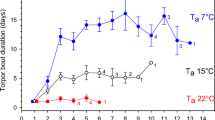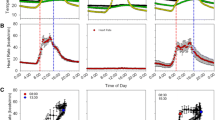Summary
Special energetic adaptations are of great evolutionary significance for birds that encounter transient problems in finding food during the breeding season. House martins, as aerial insectivores, encounter such problems during spells of bad weather, when they must survive on body reserves. This species employs the following behavioural and physiological adaptations to save energy: Low basal metabolic rate (only 43% of the values predicted by allometric equations); low thermal conductance 51% (day) and 67% (night) of the predicted values; clustering behaviour; high tolerance of the young to periods of low food supply; and the ability to become torpid, found in adults and young from the age of 11 days on. House martins are the first passerine birds in which torpor has been found. These adaptations might have played a role in the great success of the house martin, one of the 10–15 most abundant bird species in Europe.
Similar content being viewed by others
Abbreviations
- BMR:
-
Basal metabolic rate, J/g·h
- C :
-
Thermal conductance, J/g·h°C
- M :
-
Energy metabolism, J/g·h
- Ta :
-
Ambient temperature, °C
- Tb :
-
Body temperature, °C
- W :
-
Body mass, g
References
Aschoff J (1981) Thermal conductance in mammals and birds: its dependence on body size and circadian phase. Comp Biochem Physiol 69A:611–619
Aschoff J, Pohl H (1970) Der Ruheumsatz von Vögeln als Funktion der Tageszeit und der Körpergröße. J Ornithol 111:38–47
Bartholomew GA, Trost CH (1970) Temperature regulation in the Speckled Mousebird, Colius striatus. Condor 72:141–146
Boersma PD (1986) Body temperature, torpor and growth in chicks of Fork-Tailed Storm-Petrels (Oceanodroma furcata). Physiol Zool 59:10–19
Dawson WR, Hudson JW (1970) Birds. In Whittow GC (ed) Comparative Physiology of Thermoregulation. Invertebrates and Non-mammalian Vertebrates, vol 1). Academic Press, New York, pp 223–310
Dunn EH (1975) The timing of endothermy in the development of altricial birds. Condor 77:288–293
Hails CJ (1979) A comparison of flight energetics in hirundines and other birds. Comp Biochem Physiol 63A:581–585
Hainsworth FR, Collins BG, Wolf LL (1977) The function of torpor in hummingbirds. Physiol Zool 50:215–222
Hainsworth FR, Wolf LL (1970) Regulation of oxygen consumption and body temperature during torpor in a hummingbird E. jugularis. Science 168:368–369
Hoffmann R, Prinzinger R (1984) Torpor und Nahrungsausnutzung bei 4 Mausvogelarten (Coliiformes). J Ornithol 125:225–237
Hund K, Prinzinger R (1974) 11 tote Mehlschwalben (Delichon urbica) in einem Naturnest. Orn Mitt 26:151
Hund K, Prinzinger R (1985) Delichon urbica — Mehlschwalbe. In: Glutz von Blotzheim UN, Bauer KM (eds) Handbuch der Vögel Mitteleuropas (vol 10/I). Aula-Verlag Wiesbaden pp 465–507
Koskimies J (1948) On temperature regulation and metabolism in the Swift, Micropus a. apus L. during fasting. Experientia 4:274–276
Krüger K, Prinzinger R, Schuchmann KL (1982) Torpor and metabolism in Hummingbirds. Comp Biochem Physiol 73A:679–689
Lasiewski RC, Dawson WR, Bartholomew GA (1970) Temperature regulation in the little Papuan Frogmouth, Podargus ocellatus. Condor 72:332–338
Löhrl H (1970) Die Auswirkung einer Witterungskatastrophe auf den Brutbestand der Mehlschwalbe Delichon urbica in verschiedenen Orten in Südwestdeutschland. Vogelwelt 92:58–66
O'Connor RJ (1975) Growth and metabolism in nestling passerines. Symp zool Soc Lond 35:277–306
O'Connor RJ (1977) Differential growth and body composition in altricial passerines. Symp zool Soc Lond 119:147–166
Peiponen V (1965) The diurnal heterothermy of the nightjar. Ann Acad Sci fenn A IV/101:1–15
Prinzinger R (1988) Energy metabolism, body-temperature and breathing parameters in nontorpid blue-naped mousebirds Urocolius macrourus. J Comp Physiol B 157:801–806
Prinzinger R, Hänssler I (1980) Metabolism-weight relationship in some small non-passerine birds. Experientia 36:1299–1300
Prinzinger R, Siedle K (1986) Experimenteller Nachweis von Torpor bei jungen Mehlschwalben, Delichon urbica. J Ornithol 127:95–96
Prinzinger R, Göppel R, Lorenz A, Kulzer E (1981) Body temperature and metabolism in the Red-Backed Mousebird (Colius castanotus) during fasting and torpor. Comp Biochem Physiol 69A:689–692
Prinzinger R, Lübben I, Jackel S (1986) Vergleichende Untersuchungen zum Energiestoffwechsel bei Kolibris und Nektarvögeln. J Ornithol 127:303–313
Reinertsen RE (1985) Energy strategies in the cold. Doctoral thesis, University of Trondheim
Rheinwald G (1970) Die Einwirkungen der Witterungskatastrophe Anfang Juni 1969 auf die Mehlschwalben Delichon urbica verschiedener Altersklasson in Riet. Vogelwelt 91:150–153
Ricklefs RE (1974) Energetics of reproduction in birds. Publ Nuttall Orn Club 15:152–292
Stoepel B (1984) Folgen der Witterungskatastrophe 1983 in Oberschwaben auf Bestand und Alterszusammensetzung bei der Mehlschwalbe (Delichon urbica). Ecol Birds 6:159–167
Stoner D (1935) Temperature and growth studies on the Barn Swallow. Auk 52:400–407
Stoner D (1945) Temperature and growth studies of the Northern Cliff Swallow. Auk 62:207–216
Weathers WW (1977) Temperature regulation in the Dusky Munia, Lonchura fuscans (Cassin), (Estrildidae). Aust J Zool 25:193–199
Yarbrough CG (1971) The influence of distribution and ecology on the termoregulation of small birds. Comp Biochem Physiol 39A:235–266
Author information
Authors and Affiliations
Additional information
A great part of these investigations were done in the laboratory of Prof. Dr. E. Kulzer, Physiologische Ökologie, Auf der Morgenstelle 28, D-7400 Tübingen, FRG
Rights and permissions
About this article
Cite this article
Prinzinger, R., Siedle, K. Ontogeny of metabolism, thermoregulation and torpor in the house martin Delichon u. urbica (L.) and its ecological significance. Oecologia 76, 307–312 (1988). https://doi.org/10.1007/BF00379969
Received:
Issue Date:
DOI: https://doi.org/10.1007/BF00379969




